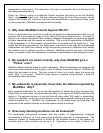
Response (FIR) filters for equalization that use sevral hundred coefficients to achieve much
higher resolution in the frequency domain than parametric bands. Furthermore, by their nature,
FIR filters simulatneously provide correction in the frequency and time domains.
The second major difference is that MultEQxt combines multiple measurements to create
equalization filters that better represent the acoustical problems in the room. Most other
methods only perform a single point measurement and this can result in making other locations
in the room sound worse than before equalization. There are some methods that use spatial
averaging to combine multiple room measurements. Although this is a step above single-point
correction, it does not always provide optimum correction. For example, it is common to find a
peak at a certain frequency in one location and a dip at the same frequency at another nearby
location. The averaging methods will add the peak and the dip and this will result in an apparent
flat response at that frequency, thus causing the equalization filter to take no action. MultEQxt
uses a clustering method to combine measurements so that acoustical problems are better
represented, thus allowing the equalization filter to perform the appropriate correction at each
location.
3. What is a target curve?
Once the room measurements are completed, MultEQxt calculates a filter for each loudspeaker
channel including the subwoofer. The role of these filters is to achieve a particular frequency
response within the entire listening area for each loudspeaker. This curve is determined based
on several acoustical and program materiial considerations and is called a “target” or
“calibration” curve.
4. What target curves does MultEQxt use?
Contrary to popular belief, a target curve that is flat from 20 Hz to 20 kHz is not always the one
that will produce the correct sound. There are several reasons for this including the fact that
loudspeakers are much more directional at high frequencies than they are at low frequencies.
This means that the balance of direct and room sound is very different at the high and low ends
of the frequency spectrum. In Denon A/V receivers equipped with MultEQxt, you have a choice
of (4) listening target curves, or ‘modes’; please note for different source inputs, your prefered
listening mode is remembered in Personal Memory Plus. These are:
The ‘Audyssey’
target curve setting makes the appropriate correction at high frequencies to
alleviate this problem. A slight roll-off is introduced that restores the balance between direct and
reflected sound.
The ‘Flat’
setting uses the MultEQxt filters in the same way as the Audyssey curve, but it does
not apply a high frequency roll-off. This setting is appropriate for very small or highly treated
rooms in which the listener is seated quite close to the loudspeakers. It is also recommended
for all rooms when the receiver is in THX processing mode. This allows THX re-equalization to
operate exactly as it was intended.
2
The ‘Front’
setting uses the MultEQxt filters that were calculated for the entire listening area, but
it does not apply any filtering to the front left and right loudspeakers. The average measured
response from the front left and right loudspeakers is used as the target curve for the remaining







